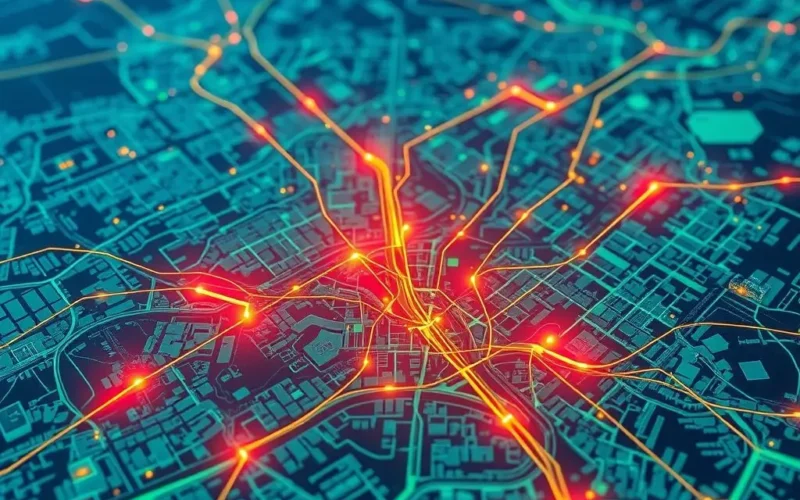Ever feel like artificial intelligence is weaving its way into every corner of our lives? From recommending your next binge-watch to suggesting who you should network with, AI is undeniably pervasive. But what about something far more serious, like predicting where criminal activity might strike next? Welcome to the world of “predictive policing” AI. It sounds like something straight out of a sci-fi thriller, doesn’t it? Imagine algorithms crunching through vast oceans of data – historical crime reports, geographical markers, even seemingly unrelated factors like time of day or weather patterns – all to pinpoint potential future hotspots for law enforcement patrols.
On the surface, the promise is compelling: optimizing resources, potentially preventing crimes before they happen, and making communities safer. Who wouldn’t want that? Yet, beneath the veneer of technological efficiency lies a complex web of ethical questions that demand serious consideration. Is using data to forecast crime truly a path toward a fairer society, or could it inadvertently amplify existing inequalities?
Table of Contents
What Exactly is Predictive Policing AI?
At its core, predictive policing utilizes analytical techniques, often powered by machine learning and artificial intelligence, to identify patterns in past crime data and other relevant information. The goal is to generate predictions about when and where future crimes are most likely to occur. This isn’t about identifying individuals who might commit crimes (that’s a different, equally complex ethical space), but rather identifying geographical areas or time windows with a higher probability of criminal events.
Think of it like advanced weather forecasting, but for crime. Instead of atmospheric pressure and temperature, the models analyze variables such as:
- Historical Crime Data: Location, type, time, and outcomes of past incidents.
- Environmental Factors: Proximity to bars, parks, schools, transportation hubs.
- Socioeconomic Data: (Though increasingly scrutinized) Demographic information, poverty levels, unemployment rates for areas.
- Temporal Factors: Day of the week, time of day, holidays, seasonal changes.
- Other Data: Sometimes includes things like calls for service, 911 data, or even social media information (though this is highly controversial).
The AI algorithms process this data to identify correlations and patterns that human analysts might miss. They then generate maps or lists highlighting areas flagged for increased attention, theoretically allowing police departments to deploy resources more effectively and proactively.

The Crucial Ethical Crossroads: Is it Fair?
Here’s where the promise meets the profound challenges. The central question isn’t whether the technology *can* predict patterns, but whether the *foundation* it builds upon and the *outcomes* it produces are equitable and just. The data fed into these algorithms isn’t a neutral, objective reflection of reality; it’s often a byproduct of historical law enforcement activities and societal structures that may carry inherent biases.
Consider this: if past policing efforts disproportionately targeted certain neighborhoods – perhaps due to existing biases, resource allocation decisions, or simply higher rates of reported low-level crimes in those areas – the historical crime data will reflect this. When a predictive algorithm learns from this data, it learns that these areas have historically high crime rates. What does it then predict? More crime in those same areas.
This can create a self-fulfilling prophecy, or what critics call a “surveillance loop” or “feedback loop”:
- Biased historical data suggests certain areas are hotspots.
- Predictive AI directs police to patrol those areas more intensely.
- Increased police presence leads to more arrests, particularly for lower-level offenses (like loitering, minor drug possession, etc.), in those targeted areas compared to others.
- This new arrest data is fed back into the AI model.
- The model reinforces its prediction that these areas are hotspots because the *data shows* more crime (specifically, more *recorded* crime/arrests).
The result? Communities already facing systemic challenges, often minority and low-income neighborhoods, risk being subjected to heightened surveillance and over-policing, regardless of the actual underlying levels of serious criminal activity compared to other areas. This isn’t just theoretical; studies and reports have documented these disproportionate impacts in cities using predictive policing tools.

Beyond Bias: Surveillance, Privacy, and Accountability
The ethical concerns extend far beyond algorithmic bias. Predictive policing tools, especially when integrated with other technologies like facial recognition or license plate readers, contribute to an environment of pervasive surveillance. Knowing that your neighborhood is constantly flagged for increased police presence can have a chilling effect on community life, restricting freedom of movement and association.
Data privacy is another significant issue. What data is being collected, how is it stored, who has access to it, and how long is it retained? The sheer volume and variety of data points used in these systems raise substantial privacy concerns for individuals residing or working in areas identified as predictive hotspots.
Then there’s the massive question of accountability. If a prediction from an algorithm leads to a police action that results in harm, who is responsible? Is it the police officer on the ground acting on the alert? The police department that purchased and implemented the software? The company that designed the algorithm? The opaque nature of many proprietary algorithms makes it incredibly difficult to understand *why* a particular prediction was made, hindering oversight and challenging traditional notions of accountability.
As we navigate these complex waters, it’s worth pausing and considering the fundamental questions posed by this technology. Are we leveraging AI to build a truly fairer future, or are we, perhaps unknowingly, automating and scaling up old prejudices and discriminatory practices?
We recently put together a quick look at this exact dilemma in a short video. It’s a lot to wrap your head around, kind of like debugging a particularly tricky piece of code!
Hopefully, that sparked a few thoughts! It really highlights the blurry line when we talk about predicting pixels and policing people.
Addressing the Challenges: Paths Forward
Acknowledging the ethical pitfalls is the first step. The development and deployment of predictive policing AI cannot happen in a vacuum. Several strategies are crucial for mitigating risks and striving for more equitable outcomes:
- Auditing and Transparency: Algorithms should be independently audited for bias and effectiveness. The underlying data sources and the logic driving predictions need to be as transparent as possible to allow for scrutiny and trust-building.
- Diverse and Clean Data: Efforts must be made to use the cleanest, least biased data possible. This might involve excluding certain data types known to perpetuate bias or actively working to collect data that reflects a more accurate picture across all communities.
- Human Oversight and Discretion: AI predictions should serve as a tool to inform, not dictate, policing decisions. Human officers must retain discretion and judgment, considering the AI’s output alongside community context and individual circumstances.
- Community Engagement: Implementing predictive policing tools should involve robust dialogue with the communities they will affect. Understanding community concerns and priorities is vital for building trust and ensuring the technology serves the public interest.
- Robust Legal and Policy Frameworks: Clear regulations are needed regarding data use, privacy, accountability, and the rights of individuals and communities impacted by predictive policing.

Frequently Asked Questions About Predictive Policing Ethics
Exploring the ethics of predictive policing brings up many questions. Here are a few common ones:
Q: Does predictive policing actually reduce crime?
A: The evidence is mixed and often debated. Some studies show potential crime reductions in targeted areas, while others are inconclusive or point to the risks of displacement (crime moving to other areas) and the negative impacts of over-policing on community trust. Measuring effectiveness is complex and depends heavily on how ‘success’ is defined and measured.
Q: Is using historical crime data inherently biased?
A: Not necessarily all of it, but historical data reflects past human actions, including policing strategies and societal biases. If those strategies disproportionately focused on certain groups or areas, the data will carry that imprint. This is why auditing data sources is critical.
Q: Can the algorithms themselves be biased?
A: Yes. Even with seemingly neutral data, how an algorithm is designed, what features it prioritizes, and how it’s trained can introduce or amplify biases present in the data or the developers’ assumptions. This is known as algorithmic bias.
Q: Who is using predictive policing AI?
A: Many police departments in major cities around the world have experimented with or adopted predictive policing tools, often from private technology vendors. The specifics of the tools and their implementation vary widely.
Q: What are the alternatives to predictive policing?
A: Alternatives and complementary approaches include community-oriented policing, addressing the root causes of crime through social programs, focused deterrence strategies targeting specific criminal behaviors, and traditional intelligence-led policing that relies more heavily on human analysis and local knowledge.

The Road Ahead
Predictive policing AI is a powerful example of how technology intersects with fundamental societal values like justice, privacy, and fairness. It offers potential benefits for public safety but carries significant risks if not developed and deployed with extreme caution and ethical mindfulness. Moving forward requires continuous evaluation, public dialogue, robust regulation, and a commitment to ensuring that these tools serve *all* communities equitably, rather than perpetuating past disparities. It’s a balancing act, and the scales of justice depend on getting it right.





